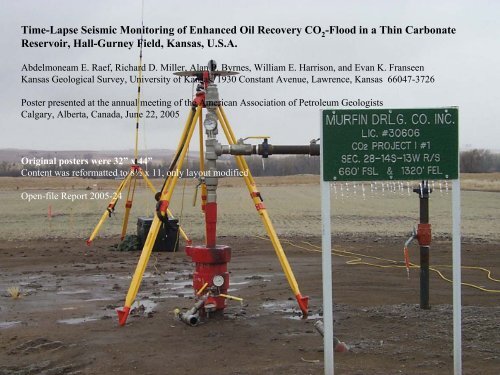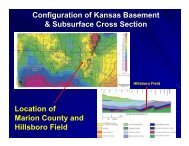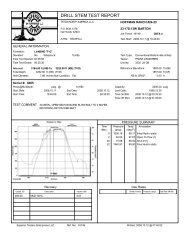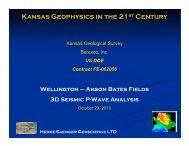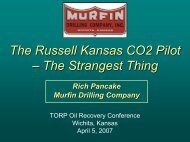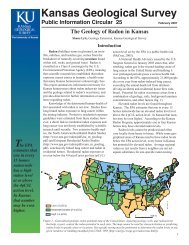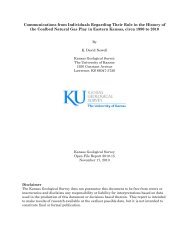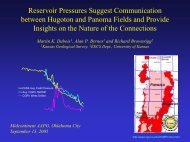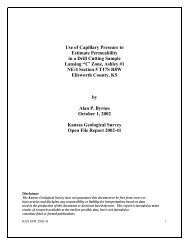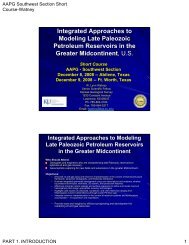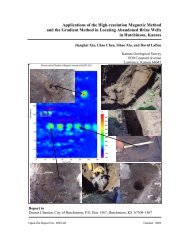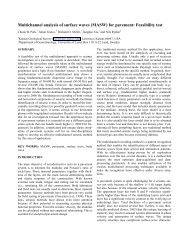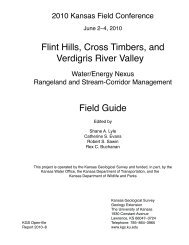Read the PDF version - the Kansas Geological Survey - University of ...
Read the PDF version - the Kansas Geological Survey - University of ...
Read the PDF version - the Kansas Geological Survey - University of ...
You also want an ePaper? Increase the reach of your titles
YUMPU automatically turns print PDFs into web optimized ePapers that Google loves.
Time-Lapse Seismic Monitoring <strong>of</strong> Enhanced Oil Recovery CO 2-Flood in a Thin CarbonateReservoir, Hall-Gurney Field, <strong>Kansas</strong>, U.S.A.Abdelmoneam E. Raef, Richard D. Miller, Alan P. Byrnes, William E. Harrison, and Evan K. Franseen<strong>Kansas</strong> <strong>Geological</strong> <strong>Survey</strong>, <strong>University</strong> <strong>of</strong> <strong>Kansas</strong>, 1930 Constant Avenue, Lawrence, <strong>Kansas</strong> 66047-3726Poster presented at <strong>the</strong> annual meeting <strong>of</strong> <strong>the</strong> American Association <strong>of</strong> Petroleum GeologistsCalgary, Alberta, Canada, June 22, 2005Original posters were 32” x 44”Content was reformatted to 8½ x 11, only layout modifiedOpen-file Report 2005-24
WHAT ARE THE MOST IMPORTANTFACTORS DETERMINING SELECTION OFA DESTINATION?1. Geographical location and Accessibility2. Cost3. Attractiveness <strong>of</strong> <strong>the</strong> destination4. High Quality MICE Infrastructure5. Security6. Unique <strong>of</strong>f-site venues7. Walkability within <strong>the</strong> destination8. Efficient public transport
Reservoir CharacteristicsReservoir rocks in <strong>the</strong> C zone are oolitic grainstones that wereoriginally deposited as shallow marine coarse-grained ooidsands concentrated on bathymetric highs on <strong>the</strong> shelf. Subaerialexposure and meteoric water percolation in <strong>the</strong> shallow shelfsetting commonly caused ooid dissolution, resulting inoomoldic grainstone textures. The dissolution <strong>of</strong> ooids alongwith fracturing and crushing (providing connectivity betweenooid molds) resulted in <strong>the</strong> oomoldic grainstones being <strong>the</strong>principal reservoir rock type (lith<strong>of</strong>acies). Each <strong>of</strong> <strong>the</strong> stackedcyclic deposits within <strong>the</strong> C zone is characterized by verticallyincreasing porosity and permeability resulting in verticalheterogeneity. Previous study <strong>of</strong> well log and core data indicatelateral lith<strong>of</strong>acies changes resulting in lateral heterogeneity.3D Seismic-Reflection ProgramDesign <strong>of</strong> <strong>the</strong> seismic survey focused on optimizing <strong>the</strong> repeatability,acquisition speed, minimized footprint, and azimuthalFigure 4. Acquisition geometry.A variety <strong>of</strong> surface obstacles affected data qualityand provided challenges during acquisition(Figure 5). <strong>Survey</strong> repeatability was continuouslychallenged by a variety <strong>of</strong> logistical aswell as practical problems. A total <strong>of</strong> nine landownerswere affected by <strong>the</strong> 2.25 km 2 sourcefootprint while geographically within this smallarea were dozens <strong>of</strong> pumping units, pastures,cultivated fields, oil field operator storage yards,a major <strong>Kansas</strong> river, wooded areas, and twocounty roads.Considering <strong>the</strong> need/necessity for repeatabilityand quiet operations, a high-resolution guidanceand surveying system was customized to provideFigure 5. Pictures from around site.PlattsburgFigure 3. Stratigraphic column for reservoir.and fold coverage, and subsurface resolution. High-foldcoverage encompasses an area about five times largerthan <strong>the</strong> anticipated size <strong>of</strong> <strong>the</strong> pilot study and plannedmovement <strong>of</strong> CO 2 (Figure 4). This enlarged high-foldfootprint ensured <strong>the</strong> expected 400 m 2 flood area wasfully sampled. Considering <strong>the</strong> range <strong>of</strong> <strong>of</strong>fsets necessaryto capture <strong>the</strong> ideal reflected seismic energy, a sourcefootprint over 1.5 km 2 and receiver spread <strong>of</strong> 1 km 2 wasnecessary.A modified brick acquisition pattern was selected tooptimize azimuthal and <strong>of</strong>fset distributions (Figure 4).This configuration is more difficult to acquire, but providesmuch better overall bin-level trace properties. Atotal <strong>of</strong> 240 receivers were deployed along five lines,each line separated by 200 m and oriented east/west.Source lines were north/south and staggered along linesseparated by 100 m. Source station intervals were 20 m,which yielded 10 m x 10 m bins with 20- to 24-foldsampling redundancy within <strong>the</strong> high-fold coverage area.source operators with a real-time digital map andlocation logging capabilities (Figure 6). Avoidingequalization techniques during data processingas much as possible was deemed essential,considering <strong>the</strong> required signal-to-noise levelsand extreme resolution necessary to detect <strong>the</strong>CO 2 . An overall accuracy <strong>of</strong> ±5 cm for all x, y,and z source and receiver location measurementswas maintained (Figure 7). Each source locationwas reoccupied during each monitoring surveyFigure 6. GPS on vib. Figure 7. GPS base station at COwithin a tolerance not exceeding 0.5 m.2 injector.Figure 8. Vib track.Data AcquisitionFigure 9. Digital terrain map.Minimal-channel recording equipment and a single vibratory source were <strong>the</strong>centerpieces <strong>of</strong> <strong>the</strong> acquisition program. Key to this equipment is <strong>the</strong> low-costseismic monitoring, small footprint, low maintenance, and dependability.A 240-channel distributed seismic recording system from Geometricsprovided 24-bit A/D, short sampling rates (by conventional standards), andextreme flexibility and durability (Figure 10). Each distributed unit wasconnected to a set <strong>of</strong> 24 geophones via analog seismic cable and to a seismiccontroller by ruggedized E<strong>the</strong>rnet cables. Data from <strong>the</strong> ten distributedseismographs (Geodes) were monitored and stored on a specialized landcontroller also from Geometrics (Figure11). The controller was housed in aJohn Deere Gator with a customizedall-wea<strong>the</strong>r shelter, allowing operationsin rain or shine from –40 to over+40° C.Figure 12. Compressional wave.Figure 13. Shear wave.Considering <strong>the</strong> obstacles aroundthis site, night operations wouldnot have been possible withouta pre-mapped route and digitalGPS guidance system, with predesignedroutes updated continuouslythrough GPS feeds inside<strong>the</strong> vibrator seismic source (Figure8). The resulting digital terrainmap was incorporated into dataprocessing, providing excellentinformation for datum corrections(Figure 9).Figure 10. Geode seismographs.A single IVI minivib II 14,000-lbseismic vibrator with a prototype highoutputAtlas rotary-style servo valveFigure 11. Recording vehicle.provided <strong>the</strong> seismic energy for <strong>the</strong>se surveys (Figure 12). In-field rotation<strong>of</strong> <strong>the</strong> mass allowed ei<strong>the</strong>r compressional- or shear-wave data to becollected using <strong>the</strong> same model vibratory source. Compressional-waveenergy requires <strong>the</strong> mass to move in a vertical direction, perpendicular to<strong>the</strong> ground surface (Figure 12), while for shear-wave energy <strong>the</strong> motion <strong>of</strong><strong>the</strong> mass was parallel to <strong>the</strong> ground (Figure 13). Five 10-second upsweepsfrom 20 to 250 Hz were recorded at each station for compressional wavesand five 10-second upsweeps from 10 to 80 Hz for shear waves. The firstsweeps were designed to seat <strong>the</strong> plate only and were not included inprocessed data.
ABBaseline Monitor 1November 2003 January 2004March 2004Monitor 3June 2004 October 2004 March 2005Figure 14. Six surveys, same station.Figure 16. Production well #12 (A), injector #18 (B).Daytime — windyFigure 19. Comparison <strong>of</strong> wind (20 mph) and calm.Night — calmMonitor 2Monitor 4 Monitor 5Figure 15. Timeline.To date, a total <strong>of</strong> six 3D surveys have been acquired (Figure 14). Time between surveys has gradually increased fromsix weeks to <strong>the</strong> current six months between consecutive 3D surveys (Figure 15). Data changes have been observeddue to seasonal wea<strong>the</strong>r and soil moisture variability. A total <strong>of</strong> twelve surveys will be necessary to adequatelycharacterize <strong>the</strong> efficiency and stability <strong>of</strong> <strong>the</strong> CO 2 flood and eventual sequestration.Figure 18. Vehicle noise on seismograms.Vehicle noiseACsurface piston pumppump jackFigure 17. Noise from field activities on seismograms.BDpowerlinewater injection pipelinesAcquisition NoiseTime-lapse seismic data possess reasonablepotential to detect changes inreservoir fluids when all noise—bothsource and environment—is consistentand minimal. Noise associated withwind, vehicles, transmission lines, andfixed pumping facilities (especially inactive oil fields) is a persistent problemwith any seismic survey. In an active oilfield, production wells (Figure 16A),injection wells (Figure 16B), and flowingpipelines produce noise at saturationlevels for most seismic recording systems(Figure 17).Much <strong>of</strong> <strong>the</strong> seismic data were acquiredat night to minimize environmental andcultural noise. Vehicle traffic was alsogreatest during <strong>the</strong> day. Re-shooting stationswhen vehicles were within <strong>the</strong> survey areawas generally necessary (Figure 18). Windwas a dominant source <strong>of</strong> noise during daylighthours (Figure 19). With <strong>the</strong> very weakanomalies, low signal-to-noise, and highresolutionrequirements associated with <strong>the</strong>sekinds <strong>of</strong> thin, midcontinent carbonate reservoirs,extraordinary care must be taken withrespect to minimizing noise.Basic Data ProcessingWith <strong>the</strong> need for horizon-based interpretationsand a high-resolution image<strong>of</strong> <strong>the</strong> CO 2 plume as it expands across<strong>the</strong> site, <strong>the</strong> detailed processing flowfocused on reflection-specific enhance-and amplitude analysis. A pro-mentscess referred to as “up-tuned, multiprocessing”was used on path<strong>the</strong>sedata sets. Instrumental to this type <strong>of</strong>processing was <strong>the</strong> modification <strong>of</strong> <strong>the</strong>basic processing flow with each step,cycling back to previous steps toimprove parameters based on downstreamanalysis (Figure 20). Subsequenttime-lapse data sets were incorporatedinto reprocessing <strong>of</strong> precedingdata sets to ensure all data underwentidentical processing flows. Signalenhancementprocessing focused onnoise removal and improvement <strong>of</strong>spectral richness (Figure 21). Datasimilarity between <strong>the</strong> various monitorsurveys was excellent, with no need forequalization processing to producecomparable preliminary seismicvolumes (Figure 22).• Vertical (temporal) resolution:• Horizontal (spatial) resolution:• Fresnel zone radiusReflecting layerDhFigure 23. Seismic resolution.rh > ¼ λr ≈ √½λDr ≈ ½ V √T 0 /fRBasic Processing FlowUp-tuned multi-path processingMonitor 2Figure 21. Signal enhancement comparison.Figure 22. Similarity <strong>of</strong> different surveys.0.25λVstackshotga<strong>the</strong>rsTrue Ampl. RecoveryNMOFigure 20. General processing flow.Velocity AnalysisStatics2000 4000Vel. m/s200-400-600-800-Time (ms.)Monitor 2–ProcessedBase Monitor 1ResolutionStacked Vol.Reverse-NMOKey to <strong>the</strong> effectiveness <strong>of</strong> seismic-reflectionimaging in many medium and small midcontinentcarbonate reservoirs is resolution, in particularvertical resolution, or <strong>the</strong> thinnest bed that can bedistinguished from a seismic wavelet (Figure 23).It is generally assumed that one-quarter <strong>of</strong> awavelength is <strong>the</strong> thinnest a bed can be and stilldetect top and bottom <strong>of</strong> <strong>the</strong> bed. These CMPstacked data possess a dominant frequency <strong>of</strong>around 90 Hz with a usable upper-corner frequency<strong>of</strong> about 180 Hz at <strong>the</strong> depth <strong>of</strong> interest.These data characteristics equate to a bed-resolutionpotential <strong>of</strong> around 7 m at 900 m belowground surface. With enhancement processing <strong>the</strong>dominant frequency is expected to improve toaround 120 Hz to 140 Hz allowing a bed-resolutionpotential <strong>of</strong> around 4 m.
Considering <strong>the</strong> importance <strong>of</strong> spatial tracking <strong>of</strong> <strong>the</strong> CO 2 plume as it movesacross this site, horizontal resolution is a key to how effective high-resolutionseismic can be monitoring any EOR program. It is commonly accepted that afraction <strong>of</strong> <strong>the</strong> radius <strong>of</strong> <strong>the</strong> first Fresnel is approximately equivalent to <strong>the</strong> sizean object must be to distinguish it as unique on a seismic section. The Fresnelradius for data from this study is about 100 m at 900 m below ground surface(Figure 24). Therefore, any object 100 m or larger can be uniquely detectedwith <strong>the</strong>se seismic data. However, changes in seismic-data character (possiblyindicative <strong>of</strong> changes in fluid) significantly smaller than <strong>the</strong> radius <strong>of</strong> <strong>the</strong>Fresnel zone can be detected.CMP Stacked Section: Seismic CubeIn general, <strong>the</strong> data quality across this siteis quite good at <strong>the</strong> L-KC depth <strong>of</strong> around550 ms (Figure 25). The various seismiccubes can be sliced inline or crosslinerelative to <strong>the</strong> receiver lines to produce 2Dcross sections. Coherent reflections areprevalent within <strong>the</strong> time window <strong>of</strong>interest (300 ms to 700 ms).Figure 25. 2D inline time slice <strong>of</strong> seismic cube.Fresnel radius (m.)3002502001501005000 500 1000 1500 2000 2500 3000Depth (m.)λ=60 m.λ=30 m.λ=10 m.Figure 24. Horizontal resolution at site.Interpretations <strong>of</strong> time slices tend to support both structural and stratigraphic influences on accumulation andmovement <strong>of</strong> fluids through <strong>the</strong> L-KC horizon (Figure 26). Some sense <strong>of</strong> <strong>the</strong> lithologic trends potentially influencingwell performance can be gained by comparing and contrasting apparent boundaries or lineaments and changes intexture <strong>of</strong> specific seismic properties across <strong>the</strong> site.A prominent feature evident in both data sets is a contrast in properties north and south <strong>of</strong> an east/west-trending line(A) lying immediately south <strong>of</strong> well #18 (Figure 26b&d). This trend (A) marks a substantial change in seismiccharacter (both amplitude and frequency) and may indicate <strong>the</strong> presence <strong>of</strong> a structural feature or an abrupt change inrock properties. Ano<strong>the</strong>r lineament (B) follows an amplitude high (red) trend (Figure 26b) and an anomalous group <strong>of</strong>frequency cells (Figure 26d). This feature, though subtle on both data sets, exhibits a sufficiently high contrast toindicate a marked change in rock properties. A third more subtle nor<strong>the</strong>ast/southwest-trending lineament (C) marks atexture change in frequency and an apparent alignment <strong>of</strong> anomalies in amplitude. Because <strong>of</strong> <strong>the</strong> greater sensitivityinstantaneous frequency has to lateral lithologic changes compared to instantaneous amplitude, it seems likely thislineament (C) is related tolithology. It is unlikely thisablineament (C) would havebeen interpreted from amplitudeplots alone.Figure 26. Both amplitude (a) andfrequency attribute plots (c) representingan over 30-m-thick interval <strong>of</strong> rockthat includes <strong>the</strong> subsurface interval <strong>of</strong>interest plus around 20 m <strong>of</strong> rockoverlying and underlying C zone at thissite possess structural and stratigraphicfeatures (b and d) consistent withknown lithology, but at much greaterresolution.cdAACCBBTime-to-Depth CorrelationsA vertical seismic pr<strong>of</strong>ile (VSP) wasacquired in well #16 and, whencorrelated with well logs, providedan excellent basis for time-to-depthcon<strong>version</strong>s. Data were acquiredwith a 24-channel hydrophonestringer (Figure 27A). Seismicarrivals trailing <strong>the</strong> first arrivalswere contaminated with tube wave,which hampered full VSP analysisFigure 27B). Using <strong>the</strong> time-to-depth con<strong>version</strong>, it is possible tobulk time-correct <strong>the</strong> syn<strong>the</strong>tic seismogram for <strong>the</strong> normalinaccuracy (< 10%) in absolute time resulting from estimatingoverburden velocity.Figure 29. “C” zone horizon on 2D time slice.AFigure 27. VSP survey at well #16 (A), seismogram from borehole (B).Heebner ShPlattsburg LsTime/Depth(sec) (m)Sonic(m/s)BAI Reflectivity KlauderWavelet200-100 HzFigure 28. Syn<strong>the</strong>tic compared to real.Sonic logs from <strong>the</strong> CO 2 injection well and well #16, combined with a seismic wavelet extracted from real data,were used to generate a conventional syn<strong>the</strong>tic seismogram (Figure 28). A C zone horizon time <strong>of</strong> 548 ms,established by incorporating <strong>the</strong> VSP and manual wavelet-correlation techniques, was tracked across all <strong>the</strong> 3Dseismicvolumes (Figure 29). Considering CO 2 injection interval is only 5 m thick—equating to little more than1 ms—it was imperative to accurately identify <strong>the</strong> L-KC “C” reflection within a few tenths <strong>of</strong> a percent.Seismic Modeling and Fluid ReplacementGassmann’s relations can be used to estimate rock-bulk modulus change for <strong>the</strong>two (effective fluid) pore-fluid compositions. For our case <strong>the</strong> two-fluidcomposition includes <strong>the</strong> combination <strong>of</strong> oil-water and miscible CO 2 -oil-water.Average composition effects <strong>of</strong> reservoir pore-fluid replacement on rockproperty suggests <strong>the</strong> maximum imageable changes will occur once saturationlevels reach 0.28, at which point a difference <strong>of</strong> about 10% in seismic amplitudeshould be expected (Figure 30).Attribute AnalysisChange %121086420Syn<strong>the</strong>tic0 0.2 0.4 0.6 0.8 1Effective Fluid Saturation (30%Oil+60%CO2+10Brine)aAverageSeismicTracer=0.68bDelta VelocityDelta DensityDelta AIFigure 30. Fluid replacement model.Lithologic relationships or trends should be observable on lineament-attribute maps <strong>of</strong> <strong>the</strong> horizon interpreted as<strong>the</strong> L-KC “C” (Figure 31). A strong nor<strong>the</strong>ast/southwest series <strong>of</strong> lineaments are evident across <strong>the</strong> entirehorizon. The most pronounced <strong>of</strong><strong>the</strong>se lineaments lies between CO 2 I#1and well #13 and extends across <strong>the</strong>entire survey area (Figure 32).Ano<strong>the</strong>r notable lineament extendsfrom about well #13 west betweenwell #12 and injector #18 (Figure32). Also evident is a secondary trend<strong>of</strong> much smaller and more discontinuouslineaments with a more eastnor<strong>the</strong>ast/west-southwesttrend, especiallypronounced in <strong>the</strong> nor<strong>the</strong>rn half<strong>of</strong> <strong>the</strong> survey area.Figure 31. Lineament map “C” horizon.Figure 32. Interpreted lineament map.
4D-Seismic InterpretationCurrently, preliminary processing and interpretationhave been completed on <strong>the</strong> baseline and first threemonitor surveys. Amplitude-envelope attribute data for<strong>the</strong>se surveys possess changes in texture generallyconsistent with expectations and CO 2 volumetrics(Figure 40). Arguably, <strong>the</strong>re are a multitude <strong>of</strong> differentboundaries that could be drawn to define <strong>the</strong> shape <strong>of</strong><strong>the</strong> CO 2 plume, but <strong>the</strong> shapes suggested match <strong>the</strong>physical restraints, based on engineering data and <strong>the</strong>estimated amplitude response. Focusing on <strong>the</strong> injectionwell area and continuity <strong>of</strong> <strong>the</strong> characteristicsdefining <strong>the</strong> anomalous area, it is not difficult to identifya notable change in data character and texturelikely associated with <strong>the</strong> displacement <strong>of</strong> reservoirfluids with CO 2 .Advancement <strong>of</strong> <strong>the</strong> CO 2 from <strong>the</strong> injector seems tohonor both <strong>the</strong> lineaments identified on baseline dataand changes in containment pressures. Overlaying <strong>the</strong>amplitude-envelope attribute map with <strong>the</strong> lineamentattribute map provides an enhanced view, and <strong>the</strong>reforeperspective, <strong>of</strong> <strong>the</strong> overwhelming variability in <strong>the</strong>reservoir rocks and <strong>the</strong> associated consistency andcontrol <strong>the</strong>se features or irregularities have on fluidmovement (Figure 41).Increased nor<strong>the</strong>rly movement <strong>of</strong> <strong>the</strong> CO 2 , as interpretedon seismic data and inferred from productiondata, after several months <strong>of</strong> CO 2 injection and oilproduction, stimulated an increase in injection rates at<strong>the</strong> water-flood wells (Figure 41B). After severalmonths <strong>of</strong> increased water-injection rates, <strong>the</strong> CO 2advancement to <strong>the</strong> northwest was halted and someregression was observed on seismic data (Figure 41A).Production data did not refute <strong>the</strong> suggested receding<strong>of</strong> <strong>the</strong> CO 2 front near injection well #10; however,insufficient well coverage exists to provide monitoringat <strong>the</strong> seismic-resolution levels.Monitor 1Monitor 2Monitor 3Interpretations <strong>of</strong> time-lapse seismic data are consistentwith and can assist understanding actual fieldresponse data for this pilot study. In a similar fashion,Figure 40. Comparison <strong>of</strong> amplitude horizon.4D seismic could clearly provide essential input toreservoir simulations necessary for full field EOR-CO 2 floods. Key observation from seismic data include:• accurate indication <strong>of</strong> solvent “CO 2 ” breakthrough in well #12,• predicted delayed response in well #13,• <strong>the</strong> interpretation <strong>of</strong> a permeability barrier between wells #13 and CO 2 I#1, and• consistency with reservoir-simulation prediction <strong>of</strong> CO 2 movement and volume estimated to havemoved north, outside <strong>the</strong> pattern.Seismic Results to Enhance Reservoir SimulationsAJanuary2004BMarch2004Simulators are only as “good” as <strong>the</strong> quality and resolution <strong>of</strong> <strong>the</strong> reservoir properties and characteristicsthat make up <strong>the</strong> models. Initial simulator runs incorporated models based on pre-injection production andwell data alone. These predictions were very dissimilar to actual production measured after commencingEOR-CO 2 injection. All interpretations <strong>of</strong> seismic data were accomplished without <strong>the</strong> aid <strong>of</strong> simulationsupdated with <strong>the</strong> most current production data; <strong>the</strong>refore, to a limited extent, <strong>the</strong> interpretations <strong>of</strong> CO 2movement on seismic data were accomplished somewhat “blind.” Predictions <strong>of</strong> breakthrough at #12 and<strong>the</strong> delay at #13 were based on seismic data alone after <strong>the</strong> second monitor survey. General changes in <strong>the</strong>CO 2 plume and resulting measurements at production wells have been consistent throughout <strong>the</strong> flood.CJune2004Monitor 1Monitor 2Monitor 3Figure 41. Comparison <strong>of</strong> amplitude envelope overlineaments.Monitor 4Figure 42. Interpretation <strong>of</strong> CO 2 and geologic controls.Interpretations <strong>of</strong> geologic features from seismicdata have provided critical location-specificreservoir properties that appear to strongly influencefluid movement in this production interval.Lineaments identified on seismic sections likely10(based on time-lapse monitoring and production12 CO 216data) play a role in sealing and/or diverting flowthrough <strong>the</strong> reservoir (Figure 42). By incorporating<strong>the</strong>se features using properties consistentwith core data, a more realistic reservoirsimulator results, honoring <strong>the</strong> production and F1813production and seismic.core properties (Figure 43). Flow models aftersimulator updating (sealing lineaments and preferential permeability manifested byfaster progression <strong>of</strong> <strong>the</strong> CO 2 bank) show great improvement in detail and provideexcellent correlation with <strong>the</strong> material balance (Figure 44).ConclusionsTime-lapse seismic monitoring <strong>of</strong> EOR-CO 2 canreveal weak anomalies in thin carbonates belowtemporal resolution and can be successful withmoderate cross-equalization and attention toconsistency in acquisition and processing details.Most <strong>of</strong> all, methods applied here avoid <strong>the</strong>complications associated with in<strong>version</strong>-basedattributes and extensive cross-equalizationtechniques.Shortness <strong>of</strong> turnaround time <strong>of</strong> time-lapseseismic monitoring in <strong>the</strong> Hall-Gurney fieldprovided timely support for reservoir-simulationadjustments and flood-management requirementsacross this very short-lived pilot study.Spatial textural, ra<strong>the</strong>r than spatially sustainablemagnitude, time-lapse anomalies were observedand should be expected for thin, shallow carbonatereservoirs. Non-in<strong>version</strong>, direct seismicattributes proved both accurate and robust formonitoring <strong>the</strong> development <strong>of</strong> this EOR-CO 2flood.Distribution and geometries associated withsimilarity-seismic facies and seismic-lineamentpatterns are suggestive <strong>of</strong> a complex ooid shoaldepositional motif, consistent with ooliticlith<strong>of</strong>acies being <strong>the</strong> known reservoir in thisfield. Oolitic facies are imaged on <strong>the</strong>se seismicdata at a resolution significantly greater thanpreviously documented.Acknowledgmentsigure 43. Variability <strong>of</strong> permeability based on101210121012CO 218CO 21818Monitor 1Monitor 2Monitor 3Figure 44. Simulations for seismic surveytimes.Support for this project was provided by <strong>the</strong> National EnergyTechnology Laboratory at <strong>the</strong> U.S. Department <strong>of</strong> Energyunder grant DE-FC26-03NT15414.CO 2131313161616


